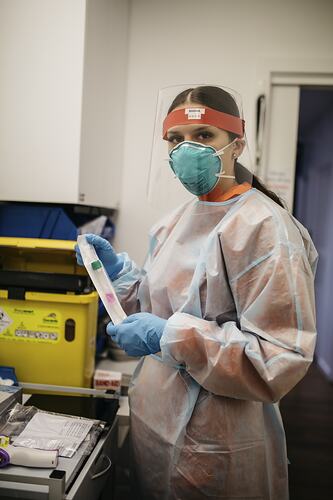Summary
Digital photograph depicting Medical Administration Officer Shania Shanahan at work at First Peoples' Health and Wellbeing (FPHW) clinic in Thomastown, Wurundjeri Woi Wurrung Country, Victoria, 25 March 2021. She is pictured dressed in full PPE and holding a Covid test in one of the clinic's consulting rooms during the COVID-19 pandemic.
First Peoples' Health and Wellbeing (FPHW)'s Thomastown clinic first opened in 2018 with an aim to improve primary healthcare access for First Peoples in the north-west region of Melbourne. In late 2019, just prior to the COVID-19 pandemic, a second FPHW clinic was opened in Frankston. The organisational ethos at FPHW, as articulated on its website in early 2021, is to 'commit to an Australian First Peoples definition of health, not just the physical well-being of an individual, but the social, emotional and cultural well-being of the whole Community' (National Aboriginal Health Strategy, 1989).
During the first 12 months of the COVID-19 pandemic Shania worked on the frontline of Covid testing at FPHW's respiratory clinic in Thomastown and was responsible for conducting saliva and nasal swab tests with patients as well as performing an array of other tasks including; medical administration, community outreach, social media outreach and phone consultations. Reflecting on her experience, Shania stated in March 2021 that 'I think to date we've done 6,000 Covid tests, so that's something to be really proud of .. we've done amazing and we continue to hold onto who we are and what we are [as First Peoples medical practitioners].'
This photograph is one of 20 photographs that were taken by curator Catherine Forge shortly before interviewing three staff members at FPHW - CEO Karinda Taylor (Wamba Wamba), Site Manager Stevie-Lee Ryan (Taungurung) and Medical Administration Officer Shania Shanahan (Arabana) - about their experiences of delivering Aboriginal-led and managed healthcare during the pandemic, including COVID-19 testing, community support programs and preparations for vaccine administration.
In this oral history interview, Karinda, Stevie-Lee and Shania discussed the various ways in which FPHW responded to the emergence of the COVID-19 pandemic, which included; rapidly setting up a respiratory clinic at the Thomastown clinic, increasing staff capacity from 7 to 27 staff members (across both the Thomastown and Frankston clinics), overcoming early challenges with limited supplies of PPE and surgical gowns, rolling out a number of flu vaccination clinics, meeting a significantly increased demand for mental health services due to social isolation during lockdown, transitioning in-person appointments to tele-health services, navigating the challenges of being situated in a 'Covid hot spot' and working with positive Covid cases, ensuring staff safety and strict sanitisation procedures at the clinic and preparing for the arrival of vaccine rollout in 2021. Beyond their on-site work at the clinic, Karinda, Stevie-Lee and Shania also discussed the wider community outreach work of FPHW, including involvement in NAIDOC week activities, active social media engagement with community via Tik Tok, Instagram and Facebook, and COVID-19 awareness raising in the Aboriginal and Torres Strait Islander community.
FPHW was one of a number of Aboriginal community-controlled health organisations and health services across Victoria that provided culturally safe, locally-led healthcare during the COVID-19 pandemic. In Melbourne, the Victorian Aboriginal Health Service (VAHS), which was first established in 1973 as Victoria's first Aboriginal community-controlled healthcare provider, also offered Covid testing services and opened a respiratory clinic in Fitzroy. VAHS provided extensive community outreach and support, including food and medicine deliveries, community events and COVID-19 awareness raising.
Physical Description
Colour digital TIFF file
Significance
With the support of the Office for Suburban Development, this is one of 20 photographs that was taken by curator Catherine Forge alongside an oral history interview that was recorded at the Thomastown clinic of FPHW on 22 March 2021. Following this interview and photoshoot, FPHW also donated a number of objects to the museum's State Collection, including: two bottles of hand sanitiser, a face mask, a staff T-Shirt (all with the FPHW logo), a surgical gown, two Covid saliva tests and an 'Always Was, Always Will Be' T-Shirt by Victorian Aboriginal-owned fashion label Clothing The Gaps.
These items provide lasting documenting of the important role of FPHW in providing Aboriginal community-controlled healthcare and Covid testing during the COVID-19 pandemic.They highlight the ancestral knowledge systems and approaches that inform First Peoples healthcare in Victoria, and represent a wide range of issues and themes including; closing the gap in Australian healthcare, trauma-informed healthcare models, traditional knowledge systems, First Peoples community outreach and solidarity, Covid testing, Covid vaccines, isolation and lockdown, mental health and wellness, cultural identity and NAIDOC week celebrations, and the various ways that First Peoples community members came together to support one another during the COVID-19 pandemic.
More Information
-
Collection Names
-
Collecting Areas
-
Acquisition Information
Collected from First Peoples Health and Wellbeing, Catherine Forge - Museums Victoria
-
Acknowledgement
Collected as part of the Museum In My Neighbourhood project with support from the Office of Suburban Development
-
Photographer
Catherine Forge - Museums Victoria, Victoria, Australia, 25 March 2021
-
Person Depicted
Karinda Taylor (Wamba Wamba) - First Peoples Health and Wellbeing, Thomastown, Victoria, Australia, 25 March 2021
-
Format
Digital file, TIFF, Colour
-
Classification
-
Category
-
Discipline
-
Type of item
-
Keywords
Pandemics, Medicine, Public Health, Indigenous Cultures, Indigenous Peoples, Vaccines, Health & Well-Being, Health Centres, Healthcare & Medicine, Aboriginal History, Aboriginal People, Medical Associations, COVID-19 Pandemic, Medical Equipment
